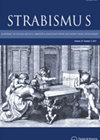
Journal Reviews archive for 2018
15 prism test for anisometropic amblyopia
The authors aimed to investigate the accuracy of the 15^ base in prism test (BIPT) in detecting amblyopia in anisometropic patients. This was a retrospective study in which the 15^BI was placed before the right eye followed by the left...
Accommodation in children
The purpose of this pilot study was to establish typical accommodative responses at 1/3m in children to targets of varying complexity and visual / cognitive demand. This was a study of 18 children aged six to seven years and six...
Binocular summation responses in strabismic amblyopia
A preliminary study was conducted to determine whether binocular summation (BS) in strabismic amblyopia is more decreased than in strabismus alone and whether strabismus surgery improves BS. The study included 15 strabismic amblyopes, 30 normal controls and 30 strabismic controls....
Choroidal thickness in strabismus and amblyopia
The authors examined the effect of exotropia, esotropia, anisometropic amblyopia and hypermetropia on choroidal thickness in a prospective cross section study. The study included 100 patients and 20 controls with a mean age of 8.5±2.9 years; 61 female and 59...
Fixation disparity measurement
The authors evaluate different procedures looking at point zero, fixation disparity (FD) and motor fusion amplitude in order to calibrate the measurement of FD with Ogle’s apparatus with the overall goal to create a standardised measurement of the FD curve...
Imaging requests for CNP
The authors sought to answer the question of to what extent do differences in policy exist between ophthalmologists and neurologists regarding imaging by MRI of patients with acquired ocular cranial nerve palsy (CNP). They conducted a literature review leading to...
International orthoptics for stroke
The purpose of this study was to consider the practice of orthoptists internationally in care provision for post stroke visual impairment through an international survey. An online survey of 30 questions was circulated via the International Orthoptic Association and completed...
Iranian prevalence of strabismus and heterophoria
Previous studies in parts of Iran report a childhood prevalence of strabismus of 1.2 to 2.3%. The authors aimed to evaluate the prevalence of strabismus in underserved rural areas of Iran in all age groups. In 2015 they conducted a...
Occlusion amblyopia
The authors report a case of binocular diplopia developing in an eight-year-old autistic child following two hours of total occlusion per day for six weeks. The child did not automatically resuppress once occlusion was stopped. Occlusion with Blenderm tape prevented...
Ocular motor score in spastic hemiplegia
The authors aimed to assess the oculomotor functions in children with spastic hemiplegia (SH) caused by different brain pathologies and evaluate the results obtained by the ocular motor score (OMS). The study included 34 children with a median age of...
Orthoptic Cochrane reviews
The purpose of this study was to explore the Cochrane Eyes and Vision (CEV) library to extract and overview protocols and systematic reviews of relevance to orthoptic practice. A full database search was made of the 2016 library. Twenty-seven systematic...
Vertical angle surgical outcomes
The surgical results of all patients undergoing isolated adjustable suture vertical squint surgery for thyroid eye disease are presented for a single centre over five years to explore the predictive factors for surgical planning. This was a retrospective study in...





